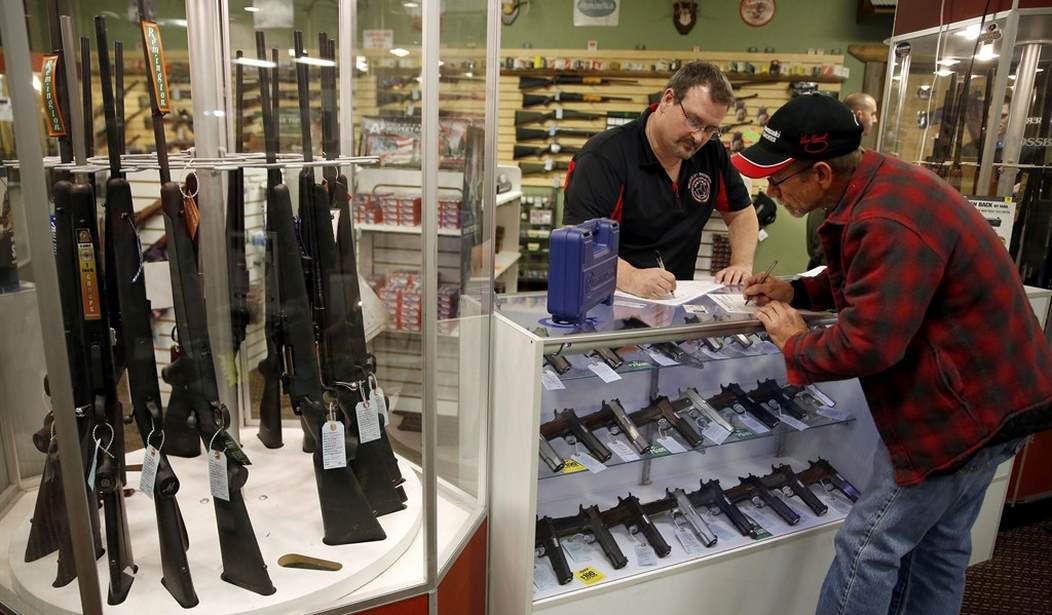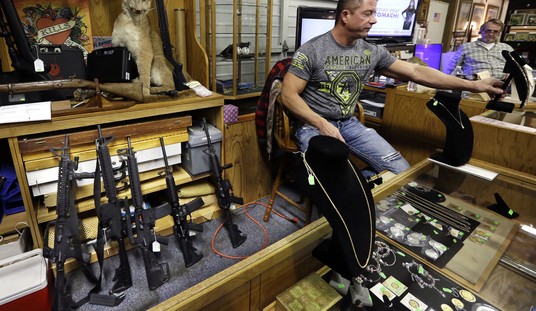Be prepared. That’s the unmistakable Boy Scout motto. So, are you?
Preparedness isn’t new to us here at Bearing Arms. We covered elements of this topic before. However, in an increasingly unpredictable world, being prepared for emergencies is an often overlooked aspect of responsible citizenship. Natural disasters, power outages, civil unrest, or even another global pandemic can strike at any moment, catching us off-guard. That’s where being prepared for whatever comes into play is vital. In fact, for responsible gun owners (that’s you, right?) it’s even more important. You have your favorite home defense tools. A firearm. Ammunition. A flashlight. You may be ready for things that go bump in the night, but what if the emergency isn’t at home, or doesn’t involve a situation where a firearm is useful? Are you prepared for whatever might come your way? What’s your plan? Do you have a plan? Do you have the resources and training to get through until help arrives? What about your family ?
As much as I’d like to answer all of these questions in the affirmative, I can’t. Despite having a supply of food and clean water for my family, multiple 72-hour kits, bug-out bags, never letting my fuel tanks drop below 1/2, and of course firearms and ample ammunition, I don’t feel prepared. The global pandemic and the civil unrest in 2020 hit me like it hit many of you–completely off guard.
For most of my life I’ve lived on the west coast. For 15 years I called the Seattle area home. We, my family and I, were prepared for the unusually strong winter storm, torrential rains, drought, fire and earthquakes. But a global pandemic, it never crossed my mind. Extended civil unrest, nope. The inability to work to provide for my family, hey, my software development experience will always be needed, right?
What does it mean to Be Prepared
In Scouting for Boys, Baden-Powell, the founder of Scouting wrote that to Be Prepared means “you are always in a state of readiness in mind and body to do your duty.” Duty. There’s a word we don’t hear often enough.
As an exercise, I asked ChatGPT, “what does being prepared mean?” Here’s what the latest and greatest AI thinks.
Being prepared can mean a few different things depending on the context, but it generally refers to the act of making ready or being equipped in advance for a particular purpose or for some use, event, or situation. Being prepared is about proactively arranging or accomplishing tasks to ensure readiness and efficiency. It typically involves foreseeing potential issues, creating contingency plans, and setting up resources or systems to handle these potential issues.
So I narrowed it’s focus to emergency preparedness and here’s what it told me.
Emergency Preparedness: This refers to the steps you take to make sure you are safe before, during, and after an emergency or natural disaster. This includes having a plan, knowing the risks of disasters in your area, having emergency supplies, and knowing how to stay informed.
Let me be the first to say, “not too shabby” to our new AI overlords. All joking aside, being prepared means we are aware of potential risks, we make a plan based on those risks, especially those in our immediate area, we have emergency supplies on hand and we stay informed. Pretty solid advice.
Basic Emergency Preparedness Tips
So what can you do if you feel less than prepared. Start one step at a time. You can find extensive guides on a myriad of preparedness topics from a number of agencies and organization. But to get you started, here are some foundational steps that anyone interested in emergency preparedness can take.
- Create an Emergency Plan: It’s crucial to have a basic plan of action for different types of emergencies. This plan should include communication methods, potential evacuation routes, and emergency meeting points. Several online sites offer comprehensive guides on how to craft these plans.
- Prepare an Emergency Kit: Having a basic emergency kit can be lifesaving in the event of a disaster. Your kit should include basic supplies like food, water, first aid supplies, flashlight, and batteries, among other things. ThePrepared.com has an extensive list of recommended supplies.
- Stay Informed: Keeping abreast of current news and understanding potential threats in your specific region can significantly increase your preparedness level.
- Learn Basic Skills: Skills like CPR, basic first aid, and knowing how to turn off your home’s utilities can be invaluable during a crisis.
- Maintain Your Kit and Plan: Regularly update your plan and replace any expired items in your kit.
Creating an Emergency Plan and Kit
Creating an emergency plan is an essential step in ensuring the safety and well-being of yourself, your family, or your organization during unexpected events. There are various resources available online and offline to help you develop a comprehensive emergency plan. Here are some places where you can find information on creating an emergency plan:
- Government Websites: Many government agencies at the national, state, and local levels offer resources and guidelines for creating emergency plans. These websites often provide specific information on natural disasters, such as hurricanes, earthquakes, floods, and wildfires, as well as other emergencies like pandemics and terrorist attacks. Look for websites from organizations like FEMA (Federal Emergency Management Agency) in the United States or the government’s emergency management agencies in other countries. FEMA provides resources and guidelines on how to build emergency kits for different types of disasters. You can visit their website at www.ready.gov/kit for detailed information on what to include in your emergency kit.
- Red Cross: The Red Cross organization has extensive resources on emergency preparedness and response. They provide guidance on creating family emergency plans, first aid training, and disaster preparedness tips. They offer guidance on creating emergency kits for various situations. Check their website at www.redcross.org/get-help/how-to-prepare-for-emergencies.html for valuable information.
- Nonprofit Organizations: Various nonprofit organizations focus on emergency preparedness and disaster management. They often provide valuable information on creating emergency plans and may offer specific guides for different types of emergencies. One
- Emergency Preparedness Apps: Several mobile apps are designed to help individuals and families create personalized emergency plans. These apps typically include features like checklists, emergency contact information, and guides for different types of emergencies.
- Community Emergency Response Teams (CERT): In some areas, local community emergency response teams offer training and resources for individuals to prepare for emergencies. Check with your local government or emergency management agency to see if CERT programs are available in your area.
- Libraries: Local libraries may have books and resources on emergency preparedness and planning. They might also host workshops or events related to emergency preparedness.
- Online Search: Conducting an online search for “how to create an emergency plan” will yield numerous articles, guides, and templates to help you get started.
When creating an emergency plan, consider factors such as the types of hazards common in your area, communication strategies, evacuation routes, meeting points, medical needs, and essential supplies. Tailor your plan to the specific needs of your household or organization. Regularly review and practice the plan with everyone involved to ensure its effectiveness during an actual emergency.
One site I’ve found incredibly helpful in my personal preparations is ThePrepared.com. (Note: They’ve recently gone through some ownership changes, so your mileage may vary. The course content they offer is top notch). Their recommendations align well with the fundamental emergency preparedness tips, but they go a step further. Their guides often delve into the nuances of different emergency scenarios, offering specific advice based on the situation, from urban survival to handling a grid-down scenario. They also emphasize the importance of community in survival situations, encouraging readers to form or join local networks of like-minded individuals to share resources, knowledge, and support. Here is their list of tips.
The Prepared‘s list of basic steps to prepping:
- Build a solid personal finance and health foundation
- Get your home ready for two weeks of self-reliance
- Be able to leave your home with only a moment’s notice (“bug out bags”)
- Prepare for emergencies that happen away from home (“get home bags” and everyday carry)
- Learn core skills and practice with your gear
- Share and recruit while continuing to learn and going beyond the basics
Emergency Preparedness for Families
Many of you have families and want to include them in your preparedness planning. Here is an outline of key steps your family can take to ensure you’re prepared for various emergencies, focusing on communication, supplies, emergency plans, and ongoing education.
1. Establish Clear Communication
Good communication is crucial during an emergency. Ensure that all family members, including children, understand what to do in different situations. Designate meeting spots inside and outside your home, and establish out-of-area contacts who can help coordinate if local lines of communication are disrupted. Additionally, keep a list of emergency contact numbers in an easily accessible location and digitally.
2. Assemble an Emergency Kit
Every family should have an emergency kit ready. This should include food, water, first aid supplies, medication, flashlights, batteries, a battery-operated or hand-cranked radio, blankets, sanitation and hygiene items, and copies of important documents. Ideally, you should have enough supplies to last each family member at least 72 hours. Remember to consider the unique needs of each family member, including pets, when assembling your kit.
3. Prepare a Family Emergency Plan
Your family should have a clear plan for different types of emergencies. This includes evacuation plans, shelter-in-place plans, and procedures for dealing with fires, earthquakes, severe storms, or other local hazards. Your plan should also include considerations for family members with special needs, such as young children, elderly family members, or those with health conditions.
4. Stay Informed
One of the best ways to prepare for emergencies is to stay informed about potential threats and hazards in your area. This could include extreme weather events, local emergency services notifications, or other relevant alerts. Make use of resources like your local news outlets, government emergency services, and apps that provide real-time updates.
5. Regularly Review and Practice Your Plans
Once your emergency plan is in place, it’s important to review and practice it regularly. This ensures that everyone in the family understands what to do and can act quickly in an emergency. As part of this process, you should also regularly update your emergency kit to replace expired items and add any new items that may be necessary.
6. Financial Preparedness
Make sure you have some cash on hand in case of emergencies where digital transactions are not possible. Also, ensure that your insurance policies are up to date and cover the types of disasters common to your area.
7. Emotional Preparedness
If you Emergencies can be stressful, and it’s important to talk about these potential situations in a calm and reassuring manner, especially with children. Providing clear information and being prepared can help reduce fear and anxiety.
Preparing for an emergency involves understanding potential risks, creating a comprehensive plan, equipping your household with necessary supplies, and maintaining open lines of communication. Although it can seem daunting, taking these steps can significantly increase your family’s safety and well-being during unexpected events. Begin today, and keep refining your plan as circumstances change or new information becomes available.
Perhaps in future columns we can tackle additional preparedness topics, but I hope this inspired you to take the first step or your next step. Let us know in the comments if you’d like to explore this topic further. I’m refining my emergency plans right now. I think you should too. Remember, take one step at a time.








